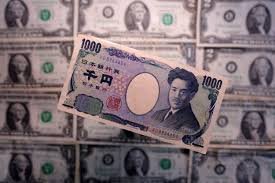The Japanese yen was significantly weakened on Thursday as the Bank of Japan (BOJ) chose to leave interest rates unchanged, citing ongoing U.S. tariffs and global trade tensions as contributing factors. In response, the U.S. dollar experienced a modest rise, supported by a more stable macroeconomic outlook and expectations from upcoming labor market data. This financial development has intensified global attention on currency volatility and its economic implications.
Yen Slides as BOJ Holds Rates Steady Amid Tariff Pressures
A notable decline in the yen was observed as a direct consequence of the BOJ’s policy stance, which was shaped by persistent concerns over the U.S.-China trade conflict. The yen slid by as much as 1.1% to 144.74 per dollar, marking its weakest level since April 10. By the end of the trading session, it had slightly recovered to 144.33 per dollar, yet it remained under considerable pressure.
Market participants interpreted the BOJ’s decision to maintain its ultra-loose monetary policy as a reflection of heightened uncertainty due to the escalating tariff landscape. It was emphasized by the BOJ that growth forecasts had to be trimmed to account for deteriorating trade conditions, fueled primarily by protectionist moves from Washington.
BOJ’s Revised Growth Outlook Sparks Market Reactions
The BOJ’s statement highlighted that economic recovery in Japan is being threatened by external factors, especially tariff-related disruptions. Growth estimates for the fiscal year were revised downward, which signaled diminished confidence in Japan’s export-driven economy.
This cautious economic outlook reinforced the BOJ’s commitment to negative interest rates and yield curve control, policies that have now been extended indefinitely due to external economic stressors. As a result, investors were driven away from the yen, traditionally seen as a safe haven during geopolitical or financial uncertainty.
Dollar Edges Higher Ahead of U.S. Jobs Data
In contrast, the U.S. dollar was modestly boosted as global investors redirected funds into dollar-denominated assets, driven by expectations of stronger U.S. labor market data and a relatively robust domestic economy. A broad gauge of the dollar’s performance saw the greenback appreciating, particularly against the yen.
Support for the dollar was also provided by rising U.S. Treasury yields, which increased as markets priced in potential interest rate hikes by the Federal Reserve later in the year. This divergence in monetary policy between Japan and the U.S. has widened yield differentials, thereby making the dollar more attractive to global investors.
Market Sentiment Driven by Trade War Developments
Much of the market’s volatility has been attributed to growing speculation around the outcome of the ongoing trade dispute between the United States and China. With tariffs being weaponized as tools of economic leverage, both currencies have been subjected to sharp movements.
Despite sporadic optimism about possible resolutions, sustained uncertainty has led central banks such as the BOJ to adopt a more cautious stance. It is being recognized by economists that the BOJ’s reluctance to tighten monetary policy is largely due to fears of exacerbating economic strain amid trade-related headwinds.
Currency Traders Watch for Signals of Recovery
Currency traders have been closely monitoring macroeconomic indicators and central bank commentary for hints of potential shifts in monetary direction. The weakening yen has prompted speculation about whether further interventions might be considered by Japanese authorities, especially if depreciation continues unchecked.
Meanwhile, attention has also been directed toward the U.S. labor market report, which is anticipated to show continued strength. Should labor market resilience be confirmed, it could reinforce expectations of monetary tightening by the Federal Reserve, thereby supporting further dollar appreciation.
Inflation Pressures Remain Key to BOJ Policy
Despite global inflation being a concern for most economies, Japan continues to grapple with the opposite problem. Low inflation and subdued wage growth have made the BOJ’s inflation target of 2% elusive. Consequently, interest rates have been held at negative levels, and bond purchases have been maintained to encourage lending and investment.
It has been suggested by policy analysts that until inflationary momentum strengthens domestically, the BOJ will have little choice but to keep its current stance. This dovish policy contrasts sharply with the more hawkish tones emerging from central banks in the West.
Outlook: Yen Vulnerability and Global Implications
Looking ahead, the yen is expected to remain vulnerable unless global trade tensions ease or domestic economic indicators show improvement. The currency’s recent depreciation could be further exacerbated if the Federal Reserve adopts a more aggressive rate-hiking approach in response to strong economic data.
In the broader context, the shift in currency values driven by central bank policies and geopolitical developments is likely to have far-reaching effects. Export competitiveness, import costs, and corporate earnings in Japan are all areas that could be impacted by the weaker yen.
As the situation evolves, investors and policymakers alike are being urged to remain cautious and responsive to the fast-changing global economic environment. With multiple central banks revisiting their policy toolkits and the geopolitical backdrop remaining uncertain, currency markets are expected to experience sustained volatility.
Conclusion
The sharp decline in the yen, triggered by the BOJ’s rate hold and lowered growth forecast, has underscored the fragile state of global markets amid persistent trade tensions. While the dollar has edged higher in response to favorable conditions in the U.S., a broader sentiment of caution continues to shape investment decisions. In the days ahead, labor market data from the U.S. and any developments in the trade war will be closely watched, as they are expected to influence central bank decisions and currency trajectories further.


